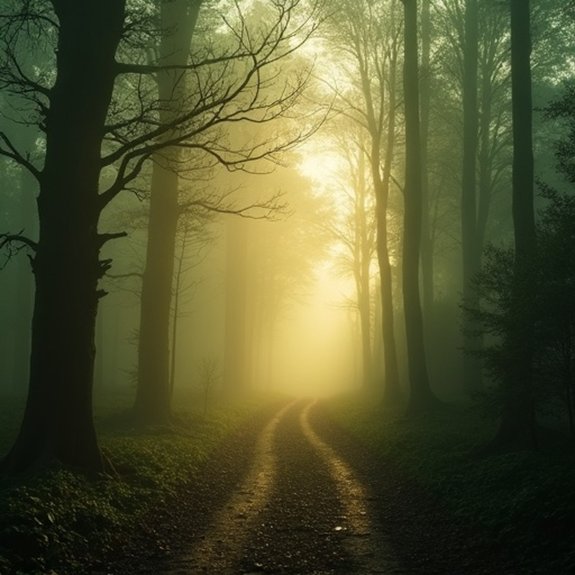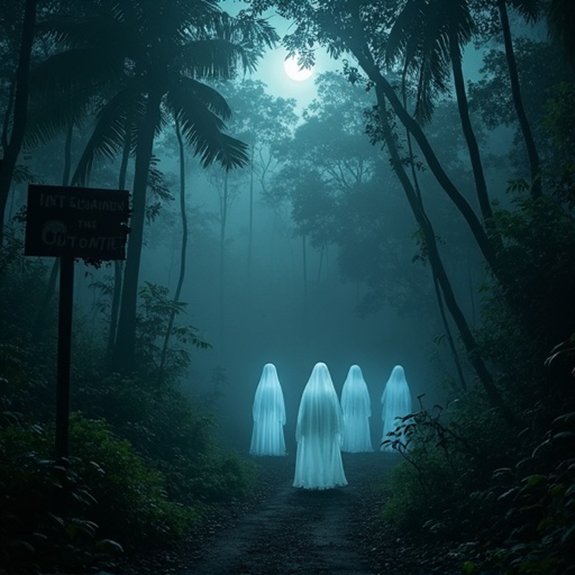The Legend of the Wandering Soul
The wandering soul legend first emerged in ancient Sanskrit texts over three thousand years ago, describing spirits trapped between worlds. These accounts don’t just chronicle supernatural encounters—they’ve shaped how entire civilizations understand death itself. From the Mahabharata’s tortured warriors to modern paranormal investigations, these restless entities follow remarkably consistent patterns across cultures. What’s most unsettling isn’t their existence but the specific conditions that create them.
Introduction

A legend whispers through the centuries about souls that can’t find peace, drifting between the world of the living and the domain of the dead. These wandering spirits appear in folklore across cultures, from Japan’s yūrei to Europe’s revenants. They’re bound to Earth by unfinished business, violent deaths, or improper burials.
The wandering soul represents humanity’s deepest fears about death and the afterlife. It embodies the terror that consciousness doesn’t simply end but continues in torment. Stories describe these entities as transparent figures who can’t touch physical objects yet influence the living through dreams, cold spots, and unexplained phenomena.
Modern paranormal investigators claim they’ve documented evidence of these restless spirits through electromagnetic readings and temperature anomalies. Whether real or imagined, the wandering soul persists as humanity’s most enduring supernatural mystery.
Ancient Sanskrit Texts’ First Mention
Though Western folklore often dominates discussions of wandering spirits, the concept’s earliest documented references appear in ancient Sanskrit texts dating back over three thousand years. The Rigveda mentions “bhutas,” restless souls who couldn’t find peace after death. These spirits wandered between dimensions, unable to reach moksha or liberation.
The Garuda Purana provides detailed descriptions of these entities. It explains that souls who died violently, left unfinished business, or weren’t properly cremated became trapped in earthly domains. They’d manifest as shadows, cold spots, or whispers in empty spaces.
Sanskrit scholars identified specific categories: pretas (hungry ghosts), pisachas (flesh-eating demons), and vetalas (corpse-inhabiting spirits). Each type had distinct characteristics and reasons for their wandering state. These classifications influenced Buddhist and Hindu spiritual practices throughout Asia.
Notable Cases or Sightings

While ancient texts established the theoretical framework for wandering souls, modern history’s documented encounters have transformed these entities from mythology into subjects of serious investigation. The 1967 Rosenheim Poltergeist case in Bavaria captivated researchers when nineteen-year-old Annemarie Schaberl’s presence triggered unexplained electrical disturbances and moving objects. Investigators couldn’t explain the phenomena through conventional means.
Japan’s Aokigahara Forest has generated over 500 reported soul sightings since 1988. Witnesses describe translucent figures who’ve appeared to lost hikers, sometimes leading them to safety. The Philippine Airlines Flight 387 incident in 1994 involved multiple passengers witnessing a ghostly woman who’d warned them about mechanical failure minutes before an engine malfunction forced an emergency landing. These cases share common elements: multiple witnesses, physical evidence, and life-altering consequences that’ve pushed paranormal research beyond mere speculation.
Common Theories or Explanations
Scientists and paranormal researchers have developed competing frameworks to explain wandering soul phenomena, each offering radically different interpretations of the evidence. Parapsychologists suggest these manifestations represent consciousness surviving bodily death, pointing to electromagnetic field disruptions and temperature anomalies at sighting locations. They’ve documented correlations between traumatic deaths and subsequent apparitions.
Skeptics propose psychological explanations instead. They attribute sightings to grief-induced hallucinations, sleep paralysis, and pattern recognition errors in low-light conditions. Neurologists cite temporal lobe activity and infrasound exposure as triggers for supernatural experiences.
Cultural anthropologists offer a third perspective. They argue wandering soul beliefs serve social functions—processing collective trauma, enforcing moral codes, and maintaining connections with ancestors. These scholars don’t debate whether souls exist but examine why societies create and perpetuate such narratives across generations.
Frequently Asked Questions
How Can I Protect Myself From Encountering a Wandering Soul?
One can’t truly protect against wandering souls since they’re supernatural entities. Folk traditions suggest carrying salt, iron objects, or religious symbols. They’d avoid walking alone at night and stay away from abandoned places where spirits linger.
What Rituals or Prayers Are Traditionally Used to Help Wandering Souls Find Peace?
Traditional communities perform ancestral offerings, burn incense, and chant prayers for the deceased’s journey. They’ll light candles to guide lost spirits, conduct memorial services, offer food and water, and recite sacred texts for liberation.
Are Wandering Souls Dangerous or Harmful to Living People?
Most cultures don’t consider wandering souls inherently dangerous, though they’re believed to cause minor disturbances like cold spots, strange noises, or feelings of unease. Some traditions warn they’ll drain energy from the living nearby.
Can Wandering Souls Communicate With the Living, and if So, How?
Yes, wandering souls can communicate with the living. They’ll appear in dreams, create unexplained sounds, move objects, leave sudden cold spots, or manifest as fleeting shadows. Some mediums claim they’re able to channel their messages directly.
What Signs Indicate a Wandering Soul Is Present in a Specific Location?
Signs of a wandering soul’s presence include sudden temperature drops, unexplained shadows moving against light sources, objects shifting without cause, whispers in empty rooms, and animals acting agitated. They’ll often leave cold spots that won’t warm.


